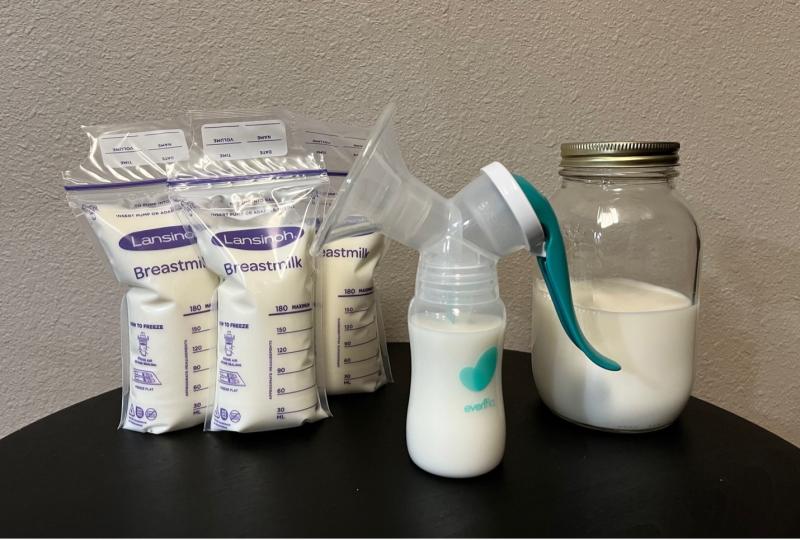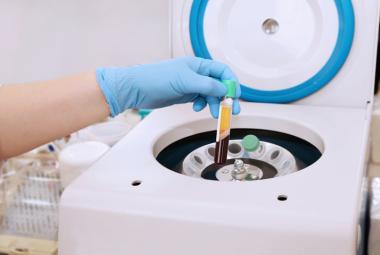In this article:
Benefits and Challenges of Breastfeeding
The Pitcher Method: Summary of Pros and Cons
Breastfeeding Guidelines related to the Pitcher Method
Breastmilk Storage Recommendations
Introduction
While breastfeeding at the breast is ideal, it is not always possible or practical. Breastfeeding moms who choose to store their breastmilk face many challenges in organizing the pumped milk and maintaining proper “use-by” dates. The Pitcher Method (pooled breastmilk collection over a 24-hour* period) may be a beneficial alternative to the traditional methods of storing breastmilk; however, there are many factors that should be considered to best meet the mother and baby’s individualized needs.
*The InfantRisk Center chooses to use a 24-hour breastmilk collection period as this was the timeframe used in preeminent research on bacterial growth. Other sources may use longer timeframes.
The nutritional contents of breastmilk vary throughout the day based on an infant’s requirements for growth and development.1 With pooled milk collection, the variability of nutritional contents is minimal, which suggests the Pitcher Method may be beneficial for premature infants with very low birth weight.2, 3 However, there may not be a distinct advantage of using the Pitcher Method in term infants compared to traditional breastmilk storage methods. There has been debate over mixing freshly expressed, warm breastmilk with refrigerated milk. Current study findings conclude mixing milk at different temperatures is unlikely to significantly impact breastmilk bacterial content.2 Established guidelines specific to storage and use-by dates of human milk should still be followed.4
Benefits and Challenges of Breastfeeding
Breastfeeding provides numerous benefits for both mothers and infants after birth, including improved cognitive development and lower rates of chronic diseases like diabetes, obesity, hypertension, cardiovascular disease, and hyperlipidemia.5 The World Health Organization (WHO) and the American Academy of Pediatrics (AAP) recommend exclusively breastfeeding infants for the first six months of life and continuing to breastfeed until the child is age two or greater..6
Unlike commercial infant formula, which adheres to tight standards and regulations, human milk composition constantly changes to provide for an infant’s needs. Consumption of human breastmilk in newborns has proven superior to infant formula, as shown by reduced incidence of necrotizing enterocolitis and re-hospitalization and improved neurodevelopmental outcomes in premature infants at 30 months.7, 8
Components of milk change with storage and fluctuations dependent on the time of day. There are many influencing factors for these components, including term versus pre-term birth, maternal ethnicity, nutritional status, and environment.9 In a study of human milk composition, differences between pre-term and term milk were identified, with higher protein and fat contents in pre-term samples.10 Studies also revealed varying bioactive factors of breastmilk (such as sIgA, lactoferrin, and ghrelin) based on the infant’s developmental stage.11 These contents are essential to the newborn’s health, especially upon pre-term birth.
There are situations in which moms may choose to pump rather than feed at the breast. In this case, the breastmilk is typically stored in a container labeled with the date and possibly time of collection, where each pump session is refrigerated or frozen separately from the others. Breastfeeding mothers face challenges in pumping, labeling, storing, and transporting small volumes of breastmilk, especially if they experience distress related to low milk production.2 Some moms have turned to the “Pitcher Method” to ease the stress of breastfeeding.
What is the “Pitcher Method”?
The Pitcher Method is a form of pooled breastmilk collection that involves storing all breastmilk pumped over a 24-hour period in a single, refrigerated container.2 Once the full day’s milk supply is collected, moms can prepare bottles for the following day and freeze any remaining milk. Moms have many factors to consider when looking to the Pitcher Method for a good routine and safe alternative to traditional breastmilk storage techniques.
For moms who pump for NICU babies, the Pitcher Method may be a safe, easier method for managing breastmilk, while providing consistent caloric feedings to premature infants. Premature infants (defined as < 28 weeks of gestation) might obtain an entire day’s supply of milk in only one pumping session. Fat and energy contents of human breastmilk are highly variable within and between samples of an own mother’s milk supply.3 Due to this natural variation, infants may have difficulty meeting the daily recommended macronutrient intake.12, 13 Minimizing variability among feeding sessions improves the likelihood of a single feeding session providing the nutrients a premature infant needs for successful growth and development. For this reason, some experts promote mixing milk from multiple pumping sessions.2, 3 The Pitcher Method is one approach to minimize this caloric variability.
Alternatively, using the Pitcher Method may come with risks, such as loss of a full day of breastmilk collection if the container is leaking or damaged. The Pitcher Method also requires transfer of the collected breastmilk (from the larger container to individual bottles or freezer bags) every 24-hours in order to meet recommended breastmilk storage criteria.4 This requirement may present challenges for moms who are preoccupied or have irregular schedules.
Additionally, there is not sufficient data available regarding the levels of other components of breastmilk (hormones, cytokines, etc.) which may be altered by the Pitcher Method. An analysis of pooled donor human milk showed variable levels of immunoglobulin and insulin between samples,1 supporting the idea that mothers’ milk contains different elements based on their bodies and their babies’ needs. Additional studies are needed to form conclusions regarding the levels of hormonal and immune components in breastmilk throughout the day and how pooling breastmilk may affect these levels.
The Pitcher Method: Summary of Pros and Cons
|
Pros |
|
|
Cons |
|
Breastfeeding Guidelines related to the Pitcher Method
Over time, there has been debate as to whether freshly expressed, warm breastmilk can be mixed with cooled milk (as performed in the Pitcher Method).
|
Date |
Is it ok to mix warm and cool breastmilk? |
|
|
2013 |
|
Stellwagen, et al. published study findings that mixing warm and cold milk does not significantly change the nutritional components 2 |
|
2017 |
|
ABM Guidelines discouraged mixing newly pumped, warm milk with previously cooled or frozen milk 4 |
|
February 2021 |
|
AAP published a statement on its website, declaring “mothers can mix warm milk and cold, or even considering pooling milk from 24 hours together…” 4, 14 |
|
September 2021 |
|
AAP modified its statement, removing guidance specific to pooled milk or mixing milk temperatures 15 |
An explanation for the AAP’s edited statement was not given; however, there is no published evidence to indicate mixing cold and warm human milk samples is unsafe. In theory, pooling milk may increase bacterial growth due to the concern for combining multiple milk temperatures and potential exposure and contamination associated with refrigeration. However, according to a study performed by Stellwagen, et al., there is not a statistically significant difference among bacterial counts in pooled milk compared to individually collected samples in the home environment.2 Based on these findings, mixing milk at different temperatures is unlikely to significantly impact breastmilk contents.
Breastmilk Storage Recommendations
Whether lactating mothers utilize the pooled breastmilk method or individual collection for each pumping session,2 temperature and use-by recommendations for human breastmilk must be emphasized. Using the Pitcher Method, each pitcher is only used for 24 hours’ worth of milk collection. This milk is used the next day or frozen within 24 hours of milk expression. This falls well within standard recommended use-by periods for refrigerated breastmilk.4
The Academy of Breastfeeding Medicine’s Clinical Protocol #10: Breastfeeding the Late Preterm and Early Term Infants has limited recommendations specific to storage and use-by dates of human milk. This may be due to the lower rates of breastfeeding among late preterm and early term infants compared to term newborns.16
The summarized recommendations for temperature control and use-by dates of human milk per the Academy of Breastfeeding Medicine’s Clinical Protocol #8 (Human Milk Storage Information for Home Use for Full-Term Infants) are as follows:4
|
Location of storage |
Recommended duration |
|
|
Freshly expressed breastmilk |
Thawed breastmilk (previously frozen milk) |
|
|
Room Temperature |
Up to 4 hours |
Up to 2 hours |
|
Refrigerator |
Up to 4 days |
Up to 24 hours |
|
Freezer |
Within 6-12 months |
Do not refreeze |
The Centers for Disease Control and Prevention (CDC) website does not have any current recommendations specific to the use of pooled breastmilk in infants. For human milk storage, the CDC guidelines reflect the ABM’s recommendations.
Conclusion
Pooling breastmilk would likely be safe and beneficial for premature infants with very low birth weight due to minimized variability among nutritional and bacterial contents. While recommendations in infants ranging from full gestation to age two or greater require less concern for meeting nutrient goals in one feeding per day, the Pitcher Method would still likely be an appropriate option. Feeding at the breast is still best. But compared to traditional breastmilk storage methods of labeling the expressed milk by day rather than emphasizing the specific time it was pumped, it is unlikely the Pitcher Method would result in any significant differences in total nutritional or bacterial components of the milk or infant outcomes related to breastfeeding. Further recommendations may develop as research studies take place.
Emily Conard, P4
Kaytlin Krutsch, PharmD
- Young, B.E., et al., Milk Bank Pooling Practices Impact Concentrations and Variability of Bioactive Components of Donor Human Milk. Front Nutr, 2020. 7: p. 579115.
- Stellwagen, L.M., et al., Pooling expressed breastmilk to provide a consistent feeding composition for premature infants. Breastfeed Med, 2013. 8: p. 205-9.
- Stoltz Sjostrom, E., et al., Intake and macronutrient content of human milk given to extremely preterm infants. J Hum Lact, 2014. 30(4): p. 442-9.
- Eglash, A., L. Simon, and M. Academy of Breastfeeding, ABM Clinical Protocol #8: Human Milk Storage Information for Home Use for Full-Term Infants, Revised 2017. Breastfeed Med, 2017. 12(7): p. 390-395.
- Binns, C., M. Lee, and W.Y. Low, The Long-Term Public Health Benefits of Breastfeeding. Asia Pac J Public Health, 2016. 28(1): p. 7-14.
- World Health Organization. Exclusive breastfeeding for six months best for babies everywhere. 2011 [cited 2022 December]. Available from: https://www.who.int/news/item/15-01-2011-exclusive-breastfeeding-for-six-months…
- Boyd, C.A., M.A. Quigley, and P. Brocklehurst, Donor breast milk versus infant formula for preterm infants: systematic review and meta-analysis. Arch Dis Child Fetal Neonatal Ed, 2007. 92(3): p. F169-75.
- Vohr, B.R., et al., Persistent beneficial effects of breast milk ingested in the neonatal intensive care unit on outcomes of extremely low birth weight infants at 30 months of age. Pediatrics, 2007. 120(4): p. e953-9.
- Gidrewicz, D.A. and T.R. Fenton, A systematic review and meta-analysis of the nutrient content of preterm and term breast milk. BMC Pediatr, 2014. 14: p. 216.
- Ballard, O. and A.L. Morrow, Human milk composition: nutrients and bioactive factors. Pediatr Clin North Am, 2013. 60(1): p. 49-74.
- Gao, X., et al., Temporal changes in milk proteomes reveal developing milk functions. J Proteome Res, 2012. 11(7): p. 3897-907.
- Rochow, N., et al., Individualized target fortification of breast milk with protein, carbohydrates, and fat for preterm infants: A double-blind randomized controlled trial. Clin Nutr, 2021. 40(1): p. 54-63.
- Fu, T.T., et al., Protein Enrichment of Donor Breast Milk and Impact on Growth in Very Low Birth Weight Infants. Nutrients, 2021. 13(8).
- Waller, J.D. AAP just quietly changed breast milk storage guidelines and moms everywhere are rejoicing. 2021 [cited 2022 July]; Available from: https://www.mother.ly/baby/aap-new-breast-milk-storage-guidelines/.
- Pediatrics, A.A.o. Breastfeeding: Frequently Asked Questions. 2021 [cited 2022 July]; Available from: https://www.aap.org/en/patient-care/breastfeeding/frequently-asked-questions/.
- Meek, J.Y., L. Noble, and A.A.o. Pediatrics, Policy Statement: Breastfeeding and the Use of Human Milk. Pediatrics, 2022. 150.







